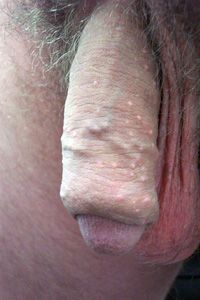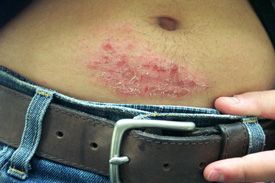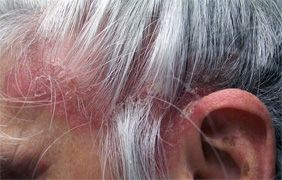Skin Disorders: 5 Shots, 5 Tips (Series #4)
Here: Ted Rosen, MD, presents 5 tips about 5 skin disorders that you might not know.
Case 1

Young adult presents with a profusion of asymptomatic, small, umbilicated penile papules. He has had unprotected intercourse with many anonymous partners.
Key point: The globoid-shaped papules with central umbilication are typical for molluscum contagiosum, a pox virus infection spread by skin-to-skin contact.
Treatment: Sharp curettage removes lesions nicely. Light liquid nitrogen cryospray may also be efficacious in some patients. When surgical intervention is impractical, topical application of various irritants (such a tretinoin or salicylic acid) or immune modifiers (such as imiquimod) may be effective.
Note: The same disorder may occur in children, usually on the trunk or face. In this instance, the disease is not sexually transmitted. Treatment options are the same.
Case 2

Teenage boy complains of an intensely pruritic patch on his abdomen. He has no similar lesions anywhere else.
Key point: The distinct localization suggests that the problem is due to something in close proximity. In fact, this is typical for true allergic contact dermatitis. The patient was found to be allergic to nickel, which is present in high concentrations in belt buckles and costume jewelry. Sweating leaches out the nickel from the metallic buckle onto the skin, eliciting an allergic reaction.
Treatment: A few days to a week of high-potency topical corticosteroid application and the troublesome spot will disappear.
Note:To prevent recurrence, the belt buckle can be coated with rhodium or simply discarded and replaced with a smaller one made of stainless steel.
Case 3

Elderly wheelchair-bound woman presents with slowly enlarging, well-demarcated but irregularly shaped, hyperpigmented rough plaque on the leg. The lesion is asymptomatic.
Key point: This is a characteristic morphology for squamous cell carcinoma in situ (Bowen disease) in people with skin of color (African American, Hispanic).
Treatment: Smaller lesions are excised or treated by curettage and electrodessication. Larger lesions may be managed by prolonged application of 5-fluorouracil or imiquimod to the point of erosion. Cryosurgery with liquid nitrogen is not sufficient.
Note: The conversion rate of these neoplasms into invasive squamous cell carcinoma is actually quite low (less than 10%).
Case 4

A 60-year-old presents with an itchy, flakey scalp. He scratches to the point of bleeding. He has pits in all fingernails and morning stiffness and pain in the lower back.
Key point: The finding of bright red, scaly plaques in the scalp that extend onto the skin at the hairline is consistent with psoriasis. Nail pitting is a classic sign of psoriasis. The patient’s arthralgias could indicate psoriatic arthritis. Thus, the likely diagnosis is psoriasis.
Treatment: Alternating daily use of a salicylic acid and a tar-containing shampoo might be sufficient. For residual disease, application of a corticosteroid-containing scalp solution until the problem essentially clears should be considered.
Note: In this late-onset psoriasis patient, family history should be sought. Without a family history of psoriasis, HIV infection is a possible trigger, and demographic risk factors should be explored.
Case 5

An 11-year-old boy presents with an extremely painful leg ulcer overlying the medial malleolus. He is known to have sickle cell disease.
Key point: Although rarely the presenting sign, leg ulcers are important, direct complications of sickle cell disease, occurring in about 8% to 10% of HbSS homozygotes in North America.
Treatment: Meticulous wound care and protection of the affected leg form trauma may suffice, although healing may take many months. For chronic ulcers (over 6 months’ duration), blood transfusion, skin grafting, Unna boot application, hyperbaric oxygen treatment, oral hydroxyurea or zinc sulfate, and use of topical platelet-derived growth factors may all be considered. Unfortunately, success or failure of these measures is based on anecdotal data; none of these interventions is guaranteed to be successful.
Note: In chronic, deep ulcers, osteomyelitis should be sought via bone scan and/or MRI. Prevention of trauma to the lower extremities may be partially protective.